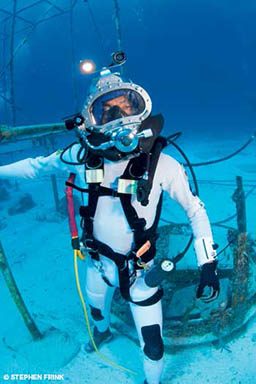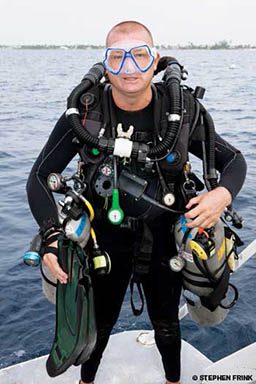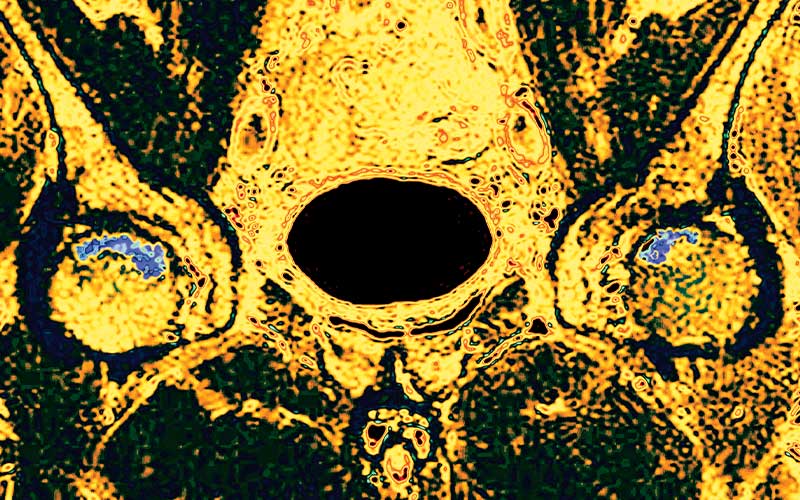Dysbaric osteonecrosis (DON) is the destruction of bone tissue in the long bones, hips and shoulders associated with diving and compressed-air work. Generally considered to be the result of circulation disruption, osteonecrosis can occur without exposure to pressure changes; indeed, cases of osteonecrosis that are unrelated to diving far outnumber cases of DON. Recognized risk factors for osteonecrosis include chronic steroid use, coagulopathies, alcoholism, smoking, antiretroviral drugs and many other conditions. The annual prevalence of symptomatic osteonecrosis in the general population is estimated at 0.2 to 0.5 percent. In at-risk populations, such as people with HIV, a prevalence of 5.6 percent was reported.

The association between decompression and osteonecrosis was initially suspected because of an unexpectedly high incidence of osteonecrosis among divers and compressed-air workers. In the 1970s, the estimated prevalence was 2 to 5 percent in Navy divers, 25 to 35 percent in tunnel workers, 16 to 55 percent in commercial divers in the U.K. and 50 to 65 percent in fishermen divers. In comparison to the risk of osteonecrosis in the general population, the risk of DON was 10 times greater in Navy divers and 100 times greater in fishermen. The risk increased with greater deviations from safe decompression procedures.
DON does not seem to be a problem for recreational divers. There are very few reported cases, and some of these may have resulted from causes other than diving. Divers risk DON with significant inert gas loading followed by inadequate decompression. Recognized recreational depth and time limits minimize the risk of DON. However, some recreational divers exceed these limits by engaging in harvesting or other commercial activities or by practicing extreme exposures as in technical diving. Turkish scuba divers have been found to be at increased risk of DON, but they seem to disregard safe decompression practices. Technical divers, on the other hand, make deep and long dives, but so far there is no indication DON affects them more than recreational divers. This may be due to safe decompression protocols or the use of more oxygen, or it may be underdiagnosed.
Occurrence of DON is not necessarily associated with a history of decompression sickness (DCS). Most cases of DON are asymptomatic at the time of onset and remain so for life. However, if damage occurs near a joint, over the years that joint may collapse and cause significant pain and disability. Such patients usually require joint replacement, which involves major and expensive surgery. Thus, DON represents a major hazard in diving with a minimal risk in recreational diving and an unknown risk in technical diving.
What are the risk factors for DON?
Emmanuel Gempp, M.D.: There is extensive medical literature dealing with this topic that goes back to the 1970s, but it deals primarily with professional divers and compressed-air workers. Although gas-bubble formation during decompression is the primary cause of DON, it alone may not be sufficient to cause ischemic bone necrosis [bone death from lack of circulation]. Dive-related factors associated with DON include the number of lifetime dives, dive depths greater than 115 to 130 feet and empirical decompression procedures. Diver-related factors include previous musculoskeletal DCS (limb bends), older age, excessive alcohol consumption, high cholesterol and coagulation abnormalities. Some researchers suspect rapid rates of compression and increased partial pressure of oxygen.
Mahito Kawashima, M.D., Ph.D.: The main risk factor is a history of musculoskeletal DCS. This was established by many studies that screened divers for DON, and it was confirmed by experimental studies with sheep. Inadequate decompression is another big factor. Divers such as fishermen who decompress empirically instead of following standard decompression procedures are at high risk. Obese divers should be careful, too.
Akin Savas Toklu, M.D.: The risk factors for DON are inadequate decompression, a history of bends, deep and long dives, a high number of dives, older age, obesity and coagulation abnormalities.
Are recreational divers at risk for DON?
Toklu: Limited studies have shown that DON is not a significant risk for recreational divers. The risk might increase with violations of decompression rules and depth or time limits. The decompression algorithms currently being used in recreational diving are safe enough that DON is unlikely if there are no other predisposing factors for osteonecrosis.

Gempp: The prevailing view is that recreational divers are at lower risk than commercial divers and compressed-air workers since they are supposed to perform dives with conservative exposures. Some anecdotal cases were observed in the past decade, but the few studies that attempted to determine the prevalence of DON among recreational divers failed to demonstrate the presence of asymptomatic bone lesions using magnetic resonance imaging (MRI).
However, repeated musculoskeletal DCS in the same location seems to put divers at increased risk of DON. We recently showed with MRI that scuba divers who experienced repeated DCS (which in 85 percent of cases was shoulder pain) developed definite DON lesions in 19 percent of cases. Those affected were mainly experienced divers who performed repetitive, long, deep air dives using dive computers and did not violate decompression procedures. We also observed that paradoxical, increasing pain during the first hyperbaric treatment might be a prognostic sign of DON development. Since 2004 we have actively followed divers who experienced musculoskeletal DCS. So far there are 33 divers in this cohort. It appears that being older than 40 and experiencing delays to recompression of more than six hours increase risk of DON. Our findings strongly suggest that routine MRI examination is justified in recreational divers treated for limb bends before they return to diving.
Kawashima: Yes. Compared to technical divers, the number of cases among recreational divers is much smaller, but some cases are reported.
Does technical diving expose divers to a higher risk of DON?
Kawashima: Yes. Deep divers, especially, are at high risk. This was shown by a group screening of Japan Agency for Marine-Earth Science and Technology (JAMSTEC) divers in which three divers among 30 were found to have DON.
Toklu: I am not aware of any published study on DON screening among technical divers, but prevalence is very low among military divers, who generally dive deep and conduct longer decompressions using mixed gas. Thus, it is possible to state that technical diving itself does not carry a higher risk of DON as long as decompression rules are strictly obeyed.
Gempp: Technical diving is theoretically regarded as a risky practice since divers are exposed to prolonged ongassing using heliox or trimix, which implies specific but often empirical decompression procedures. However, in the past five years only two nonmilitary, noncommercial divers using trimix were treated for musculoskeletal DCS in our hyperbaric center. In both cases screening for DON lesions was negative. There are many reasons for this discrepancy; principal among them is the small number of subjects.

Is there any justification for screening technical divers for DON?
Gempp: At present it is premature to impose systematic radiological investigations before determining (with future studies) the real prevalence of asymptomatic DON in this population. Detection of clotting-factor disorders that may contribute to the occurrence of DON is promising, but additional research is needed.
Kawashima: Yes. X-rays of shoulders, knees and hips were effective in catching divers at risk. Today, an MRI at the site of previous bends may be a better choice since X-ray photos can miss signs of DON in asymptomatic patients.
Toklu: An X-ray was routinely used to screen divers for DON in the past, but it is currently not recommended because of the hazardous effects of radiation. An MRI of long bones is more sensitive and allows early diagnosis of DON without radiation. It may be used in technical divers, who might undergo it if they ever have signs of DCS or report omitted decompression or any discomfort or pain in their shoulders or hips.
What protective measures other than safe decompression protocols might technical divers consider?
Toklu: A physical examination and blood tests may be recommended to screen out known risk factors for aseptic bone necrosis. Smoking is strongly discouraged because it predisposes to both diving- and nondiving-related diseases. It should be kept in mind that alcohol intake is also provocative for osteonecrosis. Divers should ensure adequate fluid intake to prevent hemoconcentration, which may predispose to DON.
Gempp: Lifestyle and dietary measures along with predive and postdive hydration may reduce the deleterious effects of venous stasis (slow blood flow)in the medullary cavities of bones following decompression. Some researchers propose that slower rates of compression might lower the incidence of DON. One recent work suggested anticoagulation therapy might reduce the risk of DON, but many side effects, particularly bleeding, outweigh the potential benefit, and thus it is not recommended.
Kawashima: The most important thing is to avoid repetitive diving and long bottom times.
Meet the Experts
Emmanuel Gempp, M.D., is a diving medical officer in the French Armed Forces Health Service and a certified mine clearance diver in the French Navy. He is a senior consultant in the department of diving and hyperbaric medicine, Sainte Anne’s Military Teaching Hospital, Toulon, France. Gempp is also an emergency medicine consultant and the author of numerous papers on dive medicine.
Mahito Kawashima, M.D., Ph.D., is executive director of Kawashima Orthopedic Hospital in Oita, Japan. He is also vice executive director of the Japanese Society of Hyperbaric and Diving Medicine and a clinical professor at Tokyo Medical and Dental University and Oita University School of Medicine. Kawashima is widely regarded as an expert on dysbaric osteonecrosis (DON) and decompression sickness. He received the 2002 Charles W. Shilling Award and the 2012 Oceaneering International Award, both given by the Undersea and Hyperbaric Medical Society.
Akin Savas Toklu, M.D., is the head of the department of underwater and hyperbaric medicine at the Istanbul Faculty of Medicine, Istanbul University, in Turkey. He is a diving and hyperbaric medicine specialist, a professor of diving and hyperbaric medicine at the University of Istanbul and a member of the European Diving Technology Committee. Toklu is a dive instructor and a medical consultant for a variety of underwater operations, including excavation, pipeline installation, salvage operation and archeological projects.
© Alert Diver — Q4 Fall 2012